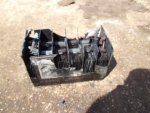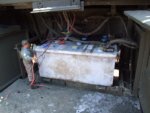There is no circuit to "accidenltly" short out if there is NO POWER going though the wiring. No posative supply no spark. BUT if the negative is isolated power IS RUNNING through the wired components ALL THE TIME . simply put if there is no current travelling the wire there is nothing to short to. IF the current IS flowing through components ALL THE TIME and they cross earth (ground) for any reason, then there is a danger. I.E. some equuiptment will use the (thier) ground to complete a circuit for the starter motor if operated without turning on the master (isolation) switch. NOW see the bang smoke or flames. If the positive is "not there" then push to crank all day, no component will try to "complete" a circuit for that operation. there is absalutly NO power for any operation. And those not to aw-fay please REMEMBER components accross one battery (for 12 volts) Will allways short to complete a 24 volt operation. (they supply (or try to))the completion of a (resitant) circuit to earth. I hope this helps as a lot of damage ensues if one forgets to a master(isolation) switch on before cranking.
So, I dont know about drag racer or others, "interperating? the complex RULE " ( convention) " So read below..and DISCONNECT THE POSITIVE LIVE wire (by an Isolation/Master switch.)
Think of your home. Connect the wires (positive negative) the "other way round" and leave a plug in and switched on, BUT the Machine swithed off with it's own switch..( while you attempt a repair) AND you WILL have a LIVE tv washing machine lawnmower whatever internals, even if it is switched off. SWITCHED OFF> hopes this keeps you all SAFE.
>>>When electricity was discovered scientists tried many experiments to find out which way the electricity was flowing around circuits, but in those early days they found it was impossible to find the direction of flow.
They knew there were two types of electric charge, positive (+) and negative (-), and they decided to say that electricity was a flow of positive charge from + to -. They knew this was a guess, but a decision had to be made! Everything known at that time could also be explained if electricity was negative charge flowing the other way, from - to +.
The electron was discovered in 1897 and it was found to have a negative charge. The guess made in the early days of electricity was wrong! Electricity in almost all conductors is really the flow of electrons (negative charge) from - to +.
By the time the electron was discovered the idea of electricity flowing from + to - (conventional current) was firmly established. Luckily it is not a problem to think of electricity in this way because positive charge flowing forwards is equivalent to negative charge flowing backwards. To prevent confusion you should always use conventional current when trying to understand how circuits work, imagine positively charged particles flowing from + to -.<<<




